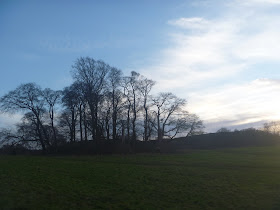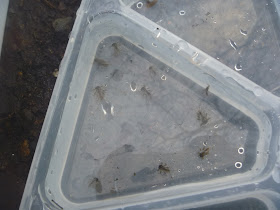I attended an excellent training course with
Buglife Scotland today -
an Introduction to Freshwater Invertebrates.
The day started with an excellent (though by necessity very speedy) introduction to the freshwater invertebrates found in Scotland by Craig MacAdam. There are many different types, including the larval forms of many species of insects that we don't think of as associated with water (it was good to be reminded that 1/3 - 1/2 of all hoverfly species start life as aquatic larvae!).
We then went outside to two sites to take water samples and see what we could find. The brave amongst us (which didn't include me) donned waders, though really wellington boots were more than adequate protection as the water isn't deep. We started at the Braid Burn
and then walked across Midmar Paddock (currently under threat of being covered in houses, you can find out more about that
here)
to Blackford Pond.
We had some basic equipment with us, much of which is repurposed kitchen equipment
We split into pairs, each pair with their own set of equipment. filled the white basin with a little water, used a net to catch invertebrates from the water then emptied the contents of the net into the basin and then caught them in the spoon and sorted them into the snack dish. Once we had studied what we had found we then released them back into the water at approximately the same point they had been removed from.
The Burn produced far more invertebrates than the pond, including these several mayfly larvae
and this lovely stonefly larva
We also found a number of caddis fly larvae in their carefully constructed cases, though none of my photos of caddis fly larvae turned out. Each species of cased caddis fly creates a different style of case using a different selection of natural and sometimes articifial materials (including for example: plant stems, shells, grains of sand and bits of plastic). Some of these cases are really beautiful (I tried to search for a good website with photos of a variety of caddis fly larval cases and couldn't find one, if I later find one I'll add the link here or feel free to let me know of such a site in the comments).
It was an excellent training day - I can thoroughly recommend Buglife courses if you're interested in invertebrates.


















































